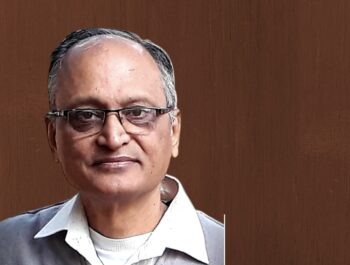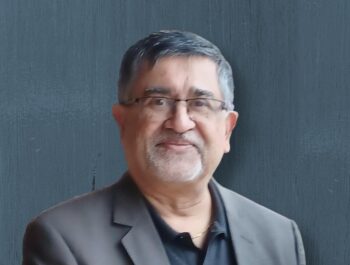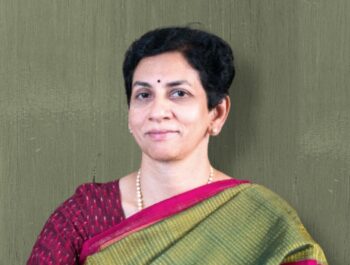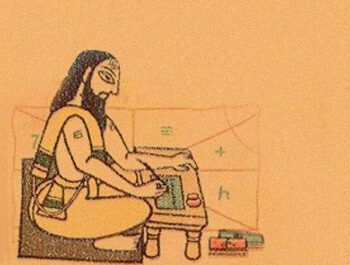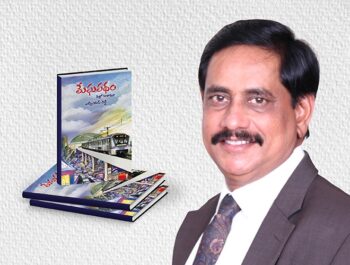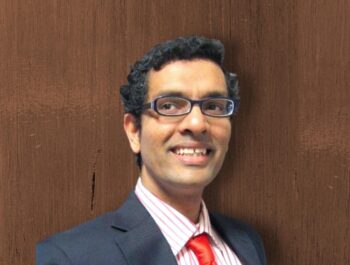INDICA’s Center for Bharatiya Languages invites you to a conversation with Professor (retd.) Dr. Vasantkumar M. Bhatt on the 10th of January (Tue) 2023 at IST 1600 hrs. This conversation, primarily in Hindi, on some aspects of sentence construction in Sanskrit, will draw from his best-selling book संस्कृत वाक्य-संरचना first published in 1996 by Saraswati Pustak Bhandar (Ratan Pola, Ahmedabad) which is already into its tenth edition in 2022. This book is written in Gujarati for those who want to learn Sanskrit as a second language.
Events Centers: CENTER FOR BHASHA STUDIES (CBS)
INDICA’s Center for Bharatiya Languages presents a conversation with Dr Sivaja Nair on the 16th of December 2022 at IST 1800 hrs in which she will introduce the magnificent Indian thesaurus: the Amarakośa. Dr Nair earned her PhD with a thesis titled The Knowledge Structure in Amarakośa. The Amarakośa, according to Dr Nair, is the most celebrated and authoritative ancient thesaurus of Sanskrit and is a book that an Indian child, one who learns from a traditional education system, memorizes as early as the first year of formal learning. She highlights the fact that though it might appear as a linear list of words, upon closer inspection, it shows a rich organisation of words expressing various relations a word bears with other words, and therefore, when the student of the traditional system studies further, the linear list of words unfolds into a knowledge web. Join us in this conversation to dive deeper into this recitable thesaurus, composed by Amarasiṃha, which truly is a landmark in the history of the Sanskrit language.
The INDICA Center for Bharatiya Languages presents a conversation with Dr Ramesh Rao, one of the authors of the book Communicating Across Boundaries – The Indian Way, published by INDICA in 2021. Indian philosophers and sages have dealt with the nature of language for thousands of years, and Indian advances in linguistics have been profound and withstood the test of time. Indians reject the idea that language has a physical foundation, and that instead, language is “Consciousness”. Philosophy of language has always been a part of the general epistemological inquiry in India, and therefore it has led to the search for evidence to verify belief and knowledge. But beyond this inquiry into the depths of our very being, languages, the very many in India, have shaped modern Indian identities. How we speak a language and what language we speak can affect our power and how we are perceived by others. How is it that in some Indian states there is a larger percentage of native language speakers than in other states? What does it say both about the mobility of Indians and the waning of the influence of some languages? What is the reality in India about multilingualism despite the avowed three-language formula? What should we do about the language of instruction? What should be the status of English in India? In this conversation, Ramesh Rao, a Professor of Communication, sketches some of the features of the Indian ‘language-scape,’ and how conflict is generated because of our language identities, choices, and abilities.
INDICA’s Center for Bharatiya Languages presents a conversation with historian Dr Chithra Madhavan on the 3rd of December at IST 1800 hrs. The title of this conversation is a part of the title of the book Sanskrit Education and Literature in Ancient and Medieval Tamil Nadu: An Epigraphical Study written by Dr Madhavan and published in 2013 by DK Printworld as part of a series titled Reconstructing Indian History and Culture. Education, especially Vedic and Vedāntic, along with allied subjects was, as the text on the back of the book brings to the fore, a prime focus of the rulers of the Tamil kingdoms. Dr Madhavan’s book highlights the educational initiatives during the reigns of the Pallava, Pāṇḍya, Coḷa, Vijayanagara, Nāyaka and other kings. Join us for what promises to be, amongst other things, an empirically sound conversation at the fascinating intersection of two classical Indian languages: Tamil and Sanskrit.
The INDICA Center for Bharatiya Languages (CBL) will host a conversation with Dr Nagaraj Paturi on October 6th 2022 (Thu) at 1600 hrs IST. This conversation intends to serve as an introduction to some facets of Telugu literature. Telugu is one of six indigenous languages recognised as “classical” (see https://pib.gov.in/newsite/PrintRelease.aspx?relid=103014 for the criteria adopted to declare a language “classical”) by the Government of India, a status it received in 2008. As per Census 2011, there were then a little over 80 million speakers of the Telugu language, about 87% of them in Andhra Pradesh (now Telangana and Andhra Pradesh). In this conversation, Dr Nagaraj Paturi, a multi-faceted, multilingual scholar, an educator with over 30 years of teaching experience at the post-graduate level and a native speaker of the Telugu language, will not just introduce the vast, growing, and thriving literature in Telugu but also discerningly analyse how the language’s history, which spans well over millennia, has been written.
Vyākaraṇa arose as the discipline of words, and ever since, has served as the grammar of thought itself. In antiquity, Vyākaraṇa is close to the revelation of the Veda itself. In purpose, it is intended to serve the living Veda as a living organ (Vedāṅga). The organic unity of the Vedāṅga disciplines concerning words, can be seen from the very births of these disciplines. The definitive Vyākaraṇa text, the Aṣtādhyāyī, contains within itself the Dhātupāṭha which also finds application in the Vedāṅga called Nirukta (Etymology). The Aṣtādhyāyī’s author Pāṇini is also the author of an authoritative text of the Vedāṅga called Śikṣā (Phonetics). Sounds and words are central to these Vedāṅga disciplines, and their scope accordingly encompassed everything in the world that sounds and words can identify and express. In how their works on Vyākaraṇa and Nirukta have the world itself as their subject matter, Pāṇini and Yāska can rightly also be counted among the earliest encyclopedists. Later luminaries in Vyākaraṇa such as Patañjali and Bhartṛhari also concerned themselves with the question of how the nature of objects can be truly described in words in a manner intelligible to other persons, thus expanding the scope of Vyākaraṇa well beyond Linguistics into Ontology and Epistemology, and also Psychology.
The Aṣtādhyāyī of Pāṇini remains the abiding gold-standard of the Sūtra format ubiquitous in Śāstra literature, be it geometry in the Śulba-sūtra or the foundational Sūtra texts of the Ṣaḍdarśana schools such as the Nyāyasūtra, Yogasūtra and Brahmasūtra. Though Vyākaraṇa has itself not been named as a school of Philosophy among the Ṣaḍdarśana-s, its indispensability to philosophical inquiry and the study of any Śāstra is extensively acknowledged. A dual foundation for the study of all disciplines, be they in the Natural Sciences or Social Sciences or Arts, is said to comprise of Kāṇāda (i.e. Logic, as formulated in the Nyāya-Vaiśeṣika systems) and Pāṇinīya (i.e. Words, under the discipline of Vyākaraṇa). All textual study is said to require investigation and understanding at the three levels of Pada (words), Vākya (statements) and Pramāṇa (proof), which are respectively the subject matter of the disciplines of Vyākaraṇa, Mīmāṃsā and Nyāya. The utility of Vyākaraṇa as an interpretive tool for Sūtra texts, is on impressive display in the commentarial texts relating to the Nyāyasūtra, Yogasūtra and Brahmasūtra by the polymath Vācaspatimiśra. Competence in Vyākaraṇa remains a prerequisite in the Vākyārtha format of scholastic discussion in any traditional Śāstra. A school of Philosophy outside of the Ṣaḍdarśana-s where Vyākaraṇa has had a uniquely distinct impact, is the Trika school, commonly referred to as the Kāśmīra Śaiva school. A fundamental subject of investigation as well as reverence in the Trika school is Vāk (the potency and phenomenon of Speech) based on the conceptualization in Vyākaraṇa texts like Bhartṛhari’s Vākyapadīya. The polymath Abhinavagupta is a representative of the Trika school, who like Vācaspatimiśra before him, adeptly wielded Vyākaraṇa as a tool of textual interpretation and philosophical inquiry.
In the vast corpus of Sanskrit poetry, the deepest and loftiest of emotions are given utterance with barely any lapse from the order of Chandas (prosody) and of Vyākaraṇa. The Itihāsa-s, namely the Rāmāyaṇa and Mahābhārata, are in a class of their when it comes to their cultural legacy, and also when it comes to how language is used in them. Usages in these epics that apparently depart from the Pāṇinian standard have traditionally been designated as ārṣa-prayoga (usage of the seers) and can in their own right be a complementary source of understanding of the use of language and its effects on human minds. In the world of the epics, practical knowledge of Vyākaraṇa is seen to be prized (as in Rāma’s praise of Hanumān’s gift of speech during their first encounter) and the terminology of Vyākaraṇa is familiar enough to supply metaphors in conversation (as Kṛṣṇa draws on in Bhagavadgītā 10:33). Sanskrit poets from Bhāsa onwards all the way to contemporary āśu-kavi-s (extempore poets) in Sāhitya-avadhāna settings have exercised immense creative freedom in content and style, without the need for the sort of poetic licence that resents or neglects Vyākaraṇa. This simultaneous commitment to the art of poetry and science of grammar is strikingly illustrated in the Bhaṭṭikāvyam, a poetic retelling of the Rāmāyaṇa which also serves the pedagogic function of teaching Vyākaraṇa through carefully designed examples.
Vyākaraṇa has through the ages been the archetypal scholastic endeavour, supplying a template for Śāstra-s to develop their formalisms, and supplying a basis of intelligibility for Kāvya to then expand the scope of expression. The symposium proceeds with to emphasis on Vyākaraṇa as applied in other Śāstra-s and Kāvya after an analysis of some key texts considered pivotal to the study of Vyākaraṇa as a meta-discipline.
:::SCHEDULE:::
| 0930-0935 | Invocation and Welcome | Megh Kalyanasundaram |
| 0935-0945 | Symposium Concept: Vyākaraṇa as a meta-discipline of Indic thought | Arvind V Iyer |
| 0945-1015 | Analysis of texts targeted at the study of Vyākaraṇa as a meta-discipline | Sowmya Krishnapur |
| 1015-1100 | Vyākaraṇa vis-à-vis Nyāya, Mīmāṃsā and Sāhitya Śāstra-s | Korada Subrahmanyam |
| 1100-1130 | The light of Vyākaraṇa in Poetry | Sharda Narayanan |
| 1130-1200 | Śabda-Yoga: Role and Significance of Vyākaraṇa for Yoga | Jayaraman Mahadevan |
| 1200-1230 | Accessibility of Vyākaraṇa across social classes: clues from Dharmaśāstra, Itihāsa and historical records | Satyan Sharma |
| 1230-1245 | Symposium Summary | Arvind V Iyer |
| 1245-1300 | Impressions and Closing remarks | Nagaraj Paturi |
This INDICA CBL talk looks to foreground some aspects of an important new Tamil translation, by Dr Jayaraman Mahadevan, of the Sanskrit text Hathayoga-Pradeepika. Written in the fifteenth century by Yogi Svatmarama, the Hathayoga-Pradeepika continues to serve as a guide to current-day yoga practices. 15 Asanas, 6 Kriyas, 8 Pranayamas, 10 Mudras, and Meditative practices such as Nadanusandhana are explained in this book. After about 120 years, this book has now been translated by Dr M Jayaraman for present-day Tamil readers. This conversation will also be of particular interest for those watching the niche space that is the intersection of Tamil and Sanskrit, both being amongst languages of profound significance to literature (and more) indigenous to the Indian subcontinent.
Meghapatham’ which means ‘Path in the clouds’, is an anthology of poems penned by Mr.NVS Reddy, a senior bureaucrat and Managing Director of the Hyderabad Metro Rail project. Hyderabad Metro Rail is a challenging mega engineering project successfully executed against innumerable hurdles under his stewardship. With the subtitle ‘Metro Kavita Jhari’, Meghapatham consists of 58 poems written in ‘Matraachchandassu’(Meter). This anthology is a reflection of his passion, trials and tribulations, and struggles and achievements in a poetic form. Each poem depicts as to how a major challenge was tackled, hurdle crossed or a sensitive issue resolved in making the dream project a reality. Apart from it’s poetic beauty, the book contains many valuable lessons for engineering and management students and practitioners. Some renowned Telugu scholars/poets who reviewed the book found it to be a unique ‘long poem’, which moulded a difficult engineering theme into beautiful poetry.
::SCHEDULE::
| # | Name | Title | Time |
| 1 | Dr. Nagaraj Paturi, Senior Director & Chief Curator, INDICA | Welcome Address & Introduction | 4.00-4.15pm |
| 2 | Sri N V S Reddy, IRAS, Author & Managing Director, Hyderabad Metro Rail Limited | Writer’s Introduction: Why Meghapatham? | 4.15-4.25pm |
| 3 | Dr. Nagaraj Paturi, Senior Director & Chief Curator, INDICA | Meghapatham Book Launch | 4.25-4.30pm |
| 4 | Prof. Kasi Reddy Venkat Reddy – President, Bharatiya Sahitya Parishat | Introduction to Meghapatham | 4.30-5.00pm |
| 5 | Sri Akella Siva Prasad, Playwright, Film Dialogue Writer & Short Story Writer | Introduction to Meghapatham | 5.00-5.30pm |
| 6 | Dr. Nagaraj Paturi, Senior Director & Chief Curator, INDICA | Introduction to Meghapatham | 5.30-6.00pm |
| 7 | Sri N V S Reddy, IRAS, Author & Managing Director, Hyderabad Metro Rail Limited | Writer’s Response | 6.00-6.30pm |
| 8 | Megh Kalyanasundaram, Director – Special Projects, INDICA | Vote of Thanks | 6.30-6.40pm |
Computer programming languages are designed to enable unambiguous human to computer and human to human communication. Historically, most programming languages have been based on English. In this talk, I propose that Indian languages like Telugu, Kannada and Samskrutam are also good candidates to base computer programming languages on. This is demonstrated using a proof of concept logo like environment implemented on top of javascript.
